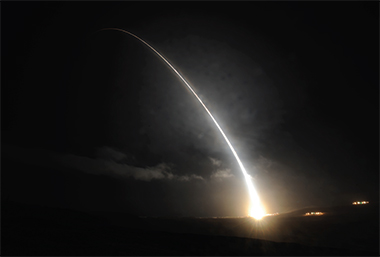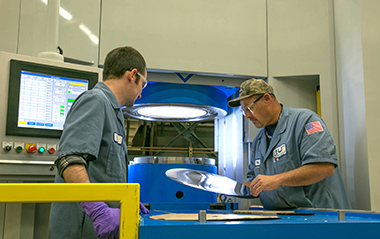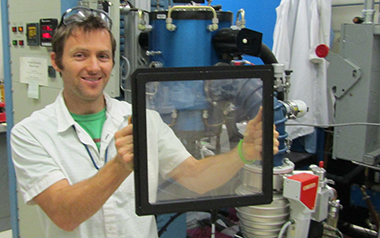Ensuring the safety, security, reliability, and effectiveness of the enduring stockpile
LLNL’s foremost responsibility is to ensure the performance of the nation’s nuclear arsenal. The knowledge gained through experiments, theory, and simulations is applied to assess the condition of stockpile weapons and to develop and certify needed modifications with confidence in the absence of nuclear explosive testing.
Annual Stockpile Assessment
In FY 2016, Livermore completed Cycle 21 of the annual stockpile assessment. The process included comprehensive peer review by the nuclear design laboratories (LLNL and Los Alamos National Laboratory) of each other’s weapons systems. LLNL scientists continue to improve the baseline weapons-physics simulation codes that support the annual assessments and certification of weapons. A wide range of stockpile surveillance activities and flight tests also provided critically needed data. For example, in September 2016, a joint DOE–Department of Defense flight test was conducted out of Vandenberg Air Force Base. The Minuteman III intercontinental ballistic missile carried an instrumented mock W87 warhead developed by LLNL.
Life-Extension Program Activities
LLNL is partnered with Sandia National Laboratories as the design agencies to develop and certify a warhead, the W80-4, for the bomber-delivered Long-Range Standoff missile. The Phase 6.2 study, now underway, to extend the stockpile lifetime of the W80 will result in a mature set of requirements and refined, cost-conscious design options. The Laboratory made excellent progress in the life-extension program (LEP)—implementing effective project management and control tools, developing design options, making necessary supportive infrastructure upgrades, and maturing component technologies. One critical need is to qualify and remanufacture additional insensitive high explosives to be used in the refurbished W80-4 warheads. Investments being made to upgrade aging high explosives facilities and infrastructure at Site 300 will support this work and a wide range of national security activities.
The design and certification process will require innovations and proficient use of NNSA’s exceptional computational and experimental resources. An area of significant innovation at LLNL is additive manufacturing (AM) to improve the quality and reduce the cost of materials and parts for weapons undergoing LEPs. Major achievements include producing parts for assembly testing (with a first-ever specific part) and developing refined capabilities to control the microstructure and physical properties of AM-produced parts. Two major hydrodynamic tests conducted in FY 2016 provided important validation data in support of the design option for the W80-4 that used the latest AM technology.
Preparing for Sierra and Beyond
In September 2016, LLNL received two Sierra “early delivery” systems, which researchers will use to explore the systems’ capabilities and test software. Sierra, a next-generation supercomputer built by IBM to be delivered in 2018, is expected to provide more than 120 petaflops (1015 floating-point operations per second) peak performance. Its procurement is part of the DOE-sponsored CORAL (Collaboration of Oak Ridge, Argonne, and Lawrence Livermore national laboratories) program to accelerate the development of high-performance computing (HPC) to meet mission needs. The collaboration is providing a strong basis for NNSA and the DOE Office of Science to pursue its Exascale Computing Project, which includes funding from DOE’s FastForward initiative for leading HPC companies to develop exascale (1018 flops) computing technologies. Livermore has led procurement activities for CORAL, FastForward, and the acquisition of next-generation capacity computing machines for the NNSA laboratories.
To prepare for the arrival of the Sierra machine, code specialists are implementing significant changes to nuclear-weapons simulations to take advantage of performance improvements made possible by the presence of graphics processing units (GPUs)—a prominent feature of the Sierra machine. Employing tools developed at LLNL, the production team for one large code, ARES, was able to speed up performance by a factor of 11 with the NVIDIA GPU (used in Sierra) as compared to that on a single core of a traditional central processing unit.
Stockpile Stewardship Experiments
Livermore successfully executed its work in the FY 2016 National Hydrodynamic Test Plan, including carrying out an integrated weapons experiment using an advanced optical technique to continually measure implosion symmetry of a mock weapon pit. This test was one of two major hydrodynamics experiments conducted to mature technologies with potential use in LEPs and improve predictive capabilities that underpin all facets of stockpile stewardship. Other tests supported the nuclear counterterrorism program and studied details about high-explosives performance. Laboratory scientists, engineers, and technicians are also engaged in design, development, and fabrication activities for subcritical experiments performed at the Nevada National Security Site.
Experiments at the Joint Actinide Shock Physics Experimental Research (JASPER) Facility and the National Ignition Facility (NIF) provide essential data about plutonium. Eleven experiments were conducted at JASPER and researchers fielded five plutonium experiments at NIF, including the first test measuring the material’s strength at extreme conditions. (Additional NIF experiments in support of stockpile stewardship are described in the National Ignition Facility section.) The experimental work is complemented by leading-edge efforts to model the complex properties of plutonium. For example, Livermore scientists developed a first-principles model that shows good agreement with recently measured magnetic properties of plutonium, a feature of the element first predicted by LLNL scientists.
Broadly Supporting the NNSA Complex
Laboratory personnel engaged in many activities to assist other sites in the Nuclear Security Enterprise. These efforts have enhanced technical capabilities at Pantex to nondestructively examine weapons pits (a technological development that won an R&D 100 Award in 2016), production methods (including AM) at the Kansas City National Security Campus, and safety processes broadly across the enterprise. In addition, LLNL has partnered with NNSA to develop the methodologies, templates, and tools for NNSA to establish an enterprise-wide infrastructure strategic plan (see Strategic Engagements and Planning).








